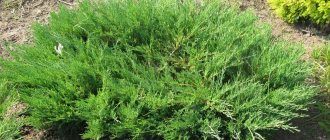Types of lupine
There are several systems that divide cultivated lupine into species.
First option. Growth division into subshrubs, subshrubs and shrubs.
Second option. Sorting plants into two subgenera and their place of distribution:
- American group, divided into North and South American;
- Mediterranean, including African species.
Third option. The most common are annual or perennial lupins .

Lupins Red Rum
Annual species
White lupine (lupinus albus), yellow lupine (lupinus luteus) and narrow-leaved or blue lupine (lupinus angustifolius) - these are the plants that are used in our country as a forage crop and green manure. They are unpretentious, frost-resistant and can reach a height of up to two meters.
Ornamental annuals include: hybrid lupine (lupinus hybridus), changeable lupine (lupinus mutabilis), dwarf lupine (lupinus nanus) and Hartweg lupine (lupinus hartwegii). In general, they are more demanding on growing conditions, as they do not tolerate cold weather. They have a large number of garden forms, varieties and hybrids.
Perennial species
Multileaf lupine (lupinus polyphyllus) and tree lupine (lupinus arboreu) are the most common varieties in Russia. They have fully adapted to climatic conditions, although the latter is still recommended for the southern regions. Thanks to D. Russell, a huge number of new varieties with bright, juicy flowers have been developed.
Of course, the plant is represented not only by the species listed above, but others, such as silver lupine (lupinus argenteus) or Nootka lupine (lupinus nootkatensis), are extremely rare in our country.
Seeds, how much they cost, what they look like
Lupine seeds vary in shape, color and size, although they are generally similar to the seeds of peas, beans and other legumes. It is an inexpensive plant because most people continue to consider it a weed. The cost of pure-grade seeds starts from 10 rubles and directly depends on the number of beans in a pack. There are sites where you can buy lupine cheaper, but to do this you need to order a batch of 50 pieces or more.

How to grow from seeds
Most often, seeds are used only in cases where it is interesting to do breeding work or one does not want to waste time on planting. Consequently, in the first case, seed material is carefully collected and selected. But in the second, lupine quickly becomes a weed, which they try to get rid of without appreciating its beauty.
A cleaner way to preserve varieties already available on the site is cuttings . But in the absence of a queen cell, seed material has to be used. It is best to choose perennial species for this. Annual varieties are more demanding on conditions, and due to the not very good germination of lupine, this can become a problem.
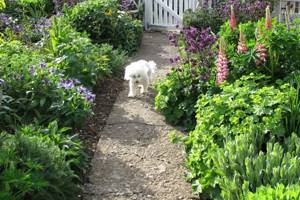
Harvest the fruits as soon as they turn yellow and begin to dry out a little. You should not allow them to ripen in the garden, since, having scattered across the flower beds, the lupine will quickly turn back into a weed, losing all the purity of its shades.
For your information. This is why hybrid varieties are not used when growing from seeds - already in the second year the plant returns to its original form (purple shades begin to predominate and white shades disappear).
To obtain seedlings, which is important for the northern regions, seeds are sown at the very beginning of spring (mid-March - early April) . This allows you to achieve earlier and more friendly flowering of lupine in the flowerbed.
Prepare deep boxes with a drainage system. Fill in the prepared soil. Plant the seeds. And expect shoots.
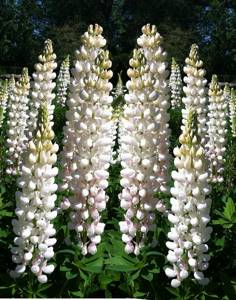
The depth of the drawers is not of fundamental importance; smaller molds can be used. A good option would be to use disposable cups (you just need to provide drainage). It should be noted that the root of the plant is quite powerful and goes deep. Accordingly, if planted untimely, it may become deformed, which will directly affect the quality of the plant being grown.
The soil mixture is made from sand, turf soil and peat. Recommended proportions are 1:2:2. Some gardeners recommend reducing the proportion of sand. In fact, the proportion is very arbitrary and largely depends on the quality of the turf land used. A prerequisite is the looseness and friability of the finished mixture. As a top dressing, you can add chopped old plant (lupine).
Seeds should be planted individually, at a distance of 30-50 cm from each other . Ideally, each bean is in its own box. You can pre-treat them with foundationazole 50% pp. Be sure to check the date on the packaging; although lupine retains good germination for 5 years, you shouldn’t take the risk.

After planting, it is recommended to water the containers and cover them with film to ensure optimal conditions. After approximately 2-3 weeks , which depends on the room temperature and plant variety, the first shoots appear. Planting in open ground should be done after the end of frost, approximately the end of April - beginning of May. Try to time it so that the plant has at least 2-4 true leaves. Still weak seedlings must be protected from strong winds. Within a few days, the lupine will quickly get used to the new territory and you don’t have to worry so much.
It is important to remember that when growing pure varieties (for collecting seeds), the plants should be separated from each other, not allowing them to cross-pollinate.
Growing lupine from seeds
Sowing
Lupine is grown from seeds through seedlings. To do this, they are sown in the first days of March in a box filled with a loose substrate, which includes turf soil, peat and sand (2:2:1). Before sowing, the seed material is combined with powdered root nodules of old lupins, this helps accelerate the growth of nitrogen-absorbing bacteria. Seedlings should appear after 7–15 days. In order for the seedlings to germinate, it is recommended to cover the crops on top with moistened gauze and place them in a warm place.
Seedling care
If you decide to grow lupins from seeds, then you need to take into account that the grown seedlings may not retain the varietal characteristics of the parent plant. As a rule, the crop is grown from seeds by breeders. Pink and purple colors are dominant, and therefore they are able to survive into the next generation. In this case, there is a high probability that the white color will be lost when growing the plant from seeds.
Seedlings are planted in open ground after they have formed two or three true leaf blades. It is not recommended to delay planting, because the tap root system develops very quickly and can be injured during transplantation.
Planting in spring

Despite its unpretentiousness, there are still a number of requirements that must be met:
- Decide in advance on the landing site . Preference should be given to an area with diffused light - lupine can tolerate direct rays of the sun, but in partial shade the shades of flowers become much brighter. It is recommended to protect the plant from the wind, or to tie them up;
- prepare the soil in the fall . You definitely need to dig up the ground, apply mineral fertilizers (a couple of tablespoons of ash per bush is usually enough) and create a drainage system - in this case, flowering will occur earlier;
- maintain the acid-base balance of the soil . With alkaline, more peat is added. For acidic conditions - lime or dolomite flour, at the rate of 5 kg per 1 sq. m. m.
It is important to remember that lupine prefers neutral soils, although it can grow in slightly acidic or slightly alkaline soils. When the recommended parameters are increased, the plant will wither and turn yellow.
Growing lupine
Location: the plant prefers sunny places.
Soil : lupins are undemanding to soil; they grow well in any garden soil, but they achieve better development in loamy, slightly acidic or slightly alkaline soils. On alkaline (pH more than 7.5) leaves turn yellow (chlorosis). Very acidic soil must be limed (an indirect indicator of high soil acidity is the presence of horsetail and coltsfoot on the site). For this purpose, finely ground dolomite or lime flour is suitable at the rate of 5 kg per 1 m2.
This amount is enough for several years, so liming is carried out once every 3-4 years - in the fall after harvesting, in the summer for a couple, in the spring before digging or in winter on snow. Peat (5 kg/m2) must be added to alkaline soil. Lupine also grows on sand, since nodules develop on its roots in which nitrogen-fixing bacteria accumulate nitrogen. Thus, the plant can do without nitrogen fertilizers.
Care : in the first year, the soil is periodically loosened and weeds are removed. In the spring of next year, they are fed with mineral fertilizers: 10-20 g of superphosphate and 5 g of potassium chloride are added per 1 m2. In old specimens, the root collar rises several centimeters above the soil surface, the middle part of the bush gradually dies, and the side rosettes become isolated. To maintain decorativeness and prolong life, plants are hilled, which promotes the development of lateral roots.
However, specimens older than four years are usually replaced as their flowering weakens. Lupine tolerates frosts down to minus 8 °C, but sharp temperature changes in spring and autumn are detrimental to it. To prolong flowering until late, dried inflorescences are cut off before seeds form. The plants grow new shoots and form inflorescences that bloom in August. Regularly cut off wilted inflorescences. Old bushes should not be replanted.
In places where winds blow, lupins must be tied to a support so that they do not break. Plants also need support during the flowering period. You can tie the flower stalks with a cord or make a wire structure in the form of several loops. The tree-like form requires shelter for the winter.
Planting before winter
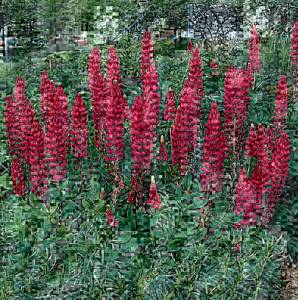
This is one of the simplest options, which is very popular with both beginners and more experienced gardeners. A clear advantage is that subsequent planting of seedlings is not required. And it’s better to use space in the house for more heat-loving plants.
Seeds should be planted towards the end of October. In this case, the lupine will not have time to germinate. The planting depth is no more than 2-2.3 cm. The top must be mulched with peat at the rate of 5 kg per square meter. As when growing at home, it is recommended to maintain the optimal distance between seeds - at least 30 cm.
Some sources recommend planting two beans per hole, but this is not a requirement. Since lupine is unpretentious, in the case of some seeds that have not sprouted, it will be easier to replant.
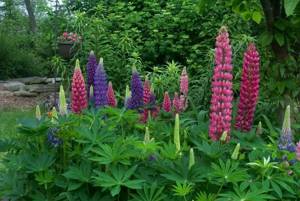
How to care
Caring for lupine does not require any specialized knowledge - this is a good plant for beginners and those who cannot regularly look after flowers:
- Carefully loosen the soil regularly and make sure that the root system is not exposed. This is especially true for two-year-old plants, in which active growth of lateral roots begins;
- in the first year, remove weeds; in the future, the lupine itself will perfectly drown them out;
- high humidity is required only during the period of bud formation, otherwise the volume and regularity of watering is individual and directly depends on climatic conditions, planting period and lupine variety;
- It is imperative to cover the plant for the winter.
To increase flowering time, wilting shoots should be removed in time, which will also help prevent lupine from self-seeding.
Despite the rather long lifespan of (perennial) lupins, it is recommended that they be completely removed after 4 years.
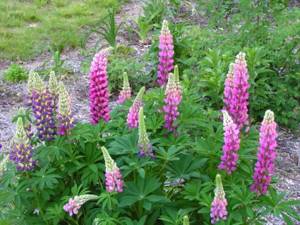
Review of the best varieties of perennial lupins
Despite the fact that not many types of lupine have been cultivated, the choice of varieties and hybrids, and therefore shapes and colors, is quite large.
The opinions of flower growers and farmers are similar - the most popular annual species are white and yellow lupins . They are good sederats, easy to care for, and not so susceptible to disease.
For example, Degas , which is a variety of white lupine, is highly valued for its good yield and resistance to fusarium. He is not afraid of overstaying and calmly tolerates excess moisture. And thanks to its small height, about 90 cm, it is resistant to lodging.
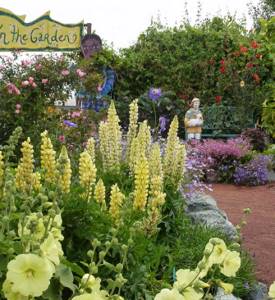
In fact, many gardeners prefer low-growing lupins. Varieties with a height of no more than 50 cm are very popular. For example, Minaret , which has a huge selection of color forms. Or Pink Fairy , which has a very pleasant aroma.
If you are interested in growing this beautiful plant, we advise you to turn to other varieties that are rare in our country. For example, small (up to 40 cm) Arctic lupine , the flowers of which have different shades of blue. Or Changeable lupine , with a long flowering period (about two months) and changeable color (lilac petals gradually change to dark red).
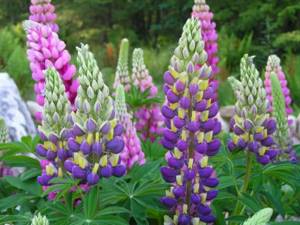
Lupine yellow. Description
A widespread annual plant in nature, also known as “wolf bean”. Homeland - Mediterranean countries. Lupine's ability to grow in any soil and rapid reproduction means that the plant can be seen even in abandoned areas. Grows everywhere: Africa, California, Sahara, Chile, Peru. This may be why it was considered a weed for a long time.

A plant with good foliage and a branched lower part reaches a height of 60-90 cm. The above-ground part consists of an erect stem and alternate leaves. The dark green leaf blades have 9 leaflets with a narrowly elongated base, resemble a fan in appearance and are covered with dense hairs on both sides.
The inflorescences of lupinus luteus are elongated, of different shades of yellow, and exude a strong, pleasant aroma. Flowers on short stalks. The growing season lasts on average 95-105 days. The flowering period lasts more than a month. As the flowers mature, they transform into hairy beans with white-pink, dark-speckled seeds. The root is taproot and can grow up to 2 meters deep. In open sunny areas it responds with rapid growth, although shaded areas are not a problem for lupine. It is resistant to fusarium and is practically not susceptible to attack by natural pests.
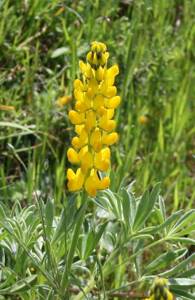
There are annual, biennial and perennial varieties, herbaceous and shrubby. All types are similar to each other: candle-shaped flowers, palm leaves. With rare exceptions, they differ in the structure of the inflorescences.
Lupine in joint plantings and its use in landscape design
Due to the fact that the plant gets along well with others, you can come up with a large number of color options. If lupine is planted in a row, then chrysanthemums, asters, and peonies will look good in the foreground.
By planting a couple of perennials nearby, such as delphinium or bluebell, you can achieve interesting transitions of blue tint. And when using cosmos and Schloss Frau lupine, all the neighbors will pay attention to the soft pink cloud.
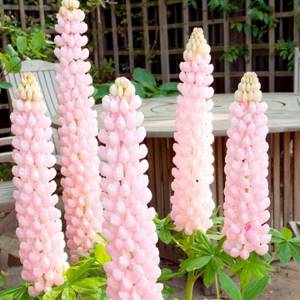
Pink Lupine
The first varieties of garden lupins were bred by British gardeners; it is not surprising that lupine looks great in English-style gardens. Its slightly casual appearance, giving the impression of a natural meadow, goes well with the rough brickwork and heavy shades of a typical English landscape.
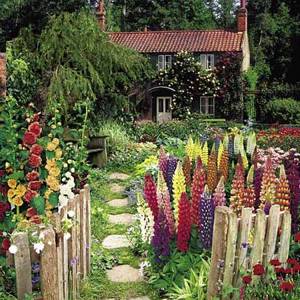
English style garden

Lupines in front of an English style house
Very often used to decorate backyards.

Pink lupins in the garden
Can also be good for creating a garden in an abandoned romantic style.
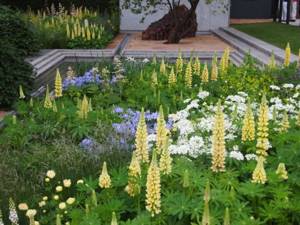
Lupine in the garden in a romantic style
At the same time, its candle-like inflorescences can look solemn and noble, and are appropriate next to well-groomed paths, lawns, flower beds, hedges, and stone borders. In this case, sparse plantings in one or two shades (white, yellow, wine, red lupine) are good, where the beauty of each individual flower is clearly visible.
White, pink and lilac lupins as an accent next to a stone path

Red lupine goes well with trimmed hedges and arches
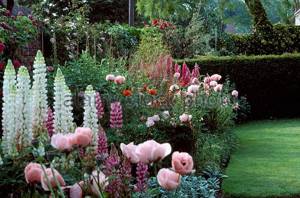
White lupins in a mixborder, where the main accent, setting the mood and softening the aggressive beauty of lupins, is delicate pale pink poppies.
Very convenient for creating borders.
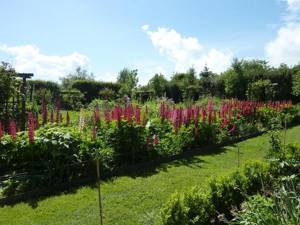
Dark red lupine in the border
Border in lilac tones with lupins, roses, clematis and hardy geraniums at Sissinghurst Castle Garden, near Cranbrook, Kent.

A border of lupines enlivens a monotonous hedge line.
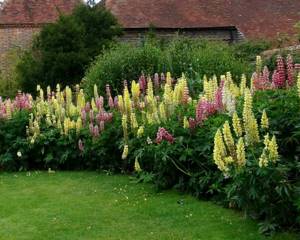
Powerful lupins successfully replace a border of bushes.
Red lupins create a series of vertical, bright lines that beautifully break up a solid wall of greenery or buildings. Very convenient for enlivening the landscape near the walls of fences and houses.
Red lupins as the only source of bright colors along an old wall. Without them, the landscape would be dull.
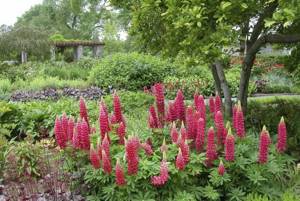
The rich red color blends harmoniously with the mature green color of the leaves and grass.
Red lupins look great in coniferous compositions.
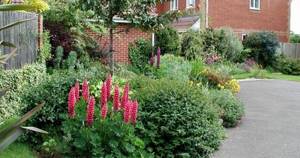
Another option for using red lupins.
They can look good in single plantings. A lush bush of dense foliage, topped with candelabra, will successfully replace a spherical thuja or any other shrub.
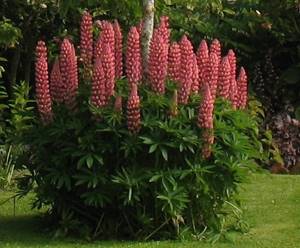
Burgundy lupine in single plantings
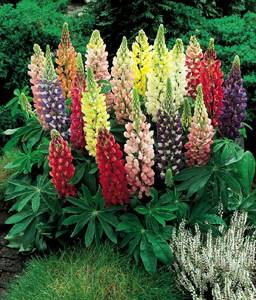
A mix of lupines planted as the only bright spot against a background of greenery
They are successfully used in mixborders and here the imagination is not limited. The only rule is that lupins require space. They are bright, noticeable, and must be balanced with other powerful plants.

A complex composition, a little fragmented, but lupins add dynamics.
Thanks to the colorfulness of lupins, you can create bright and sometimes unusual color accents.
White-yellow lupine sets off the dark deep green of the pine needles.
White and light yellow lupins slightly dilute the contrasting combination of bright yellow and bright blue flowers.
Spring color combination: lilac-pink-lilac lupins.
Autumn landscape: rich yellow, burgundy, red, orange shades of lupins.
Vertical lines of multi-colored lupins unite flashes of bright poppy heads.
Lupine and wisteria combine amazingly; it’s just a pity that wisteria does not grow in central Russia (although there is information that winter-hardy varieties of wisteria have begun to be developed). The photo below shows the famous Kawachi Fuji Garden in Japan.

Wisteria and lupins at Kawachi Fuji Gardens, Japan
Lupines - a lush garden decoration
In our village, lupine probably grows in every yard.
And also along the roadsides, along ditches, under trees... When it blooms, it looks simply luxurious! Tall candle inflorescences of various colors and shades enliven front gardens and landscapes outside the outskirts. Lupine at the old fence. Photo by the author
Yes, in the middle zone lupine is often found simply as wild grass in meadows and clearings. Most often - the most common one, purple, but you can also see white and pink ones. And if a single flower is simply beautiful, then large groups of lupins - both single-color and multi-colored - are truly magnificent!
In our area, lupine glades can be found in the wild. Photo by the author
Probably, in our area this plant has found ideal conditions for itself: fairly loose soil with good water permeability, slightly acidic, moderately fertile. Lupines do not like lime in the soil and grow poorly with excess fertilizer , but at the same time, like most legumes (and this is the family they belong to), they are able to improve the soil, enriching it with nitrogen accumulated in root nodules.
Multi-colored lupins feel great in the meadow. Photo by the author
By the way, this perennial develops a powerful, deep and strong root system, so it is better to replant young plants - adults can get sick for a long time after replanting.
If you decide to replant lupine, choose young plants. Photo by the author
Lupines are also propagated by seeds - there are different varieties on sale with all sorts of bright and expressive colors. Lupine seeds are large, with a hard shell, so it is recommended to scarify (that is, slightly damage the surface of the seed: it needs to be lightly rubbed with sandpaper or a nail file) and soaking for several hours before sowing. But in its wild form, this plant reproduces well by seeds and without additional procedures.
A wide range of lupine seeds are presented in our catalog, which includes offers from major online gardening stores. View the selection and choose lupine varieties for your garden .
Lupine perennial Aristocrat, 0.45 g 26 RUR
seedspost.ru
Russell's Lupine White Flame, 0.5 g 26 RUR
seedspost.ru
Perennial lupine Countess, 0.45 g 26 RUR
seedspost.ru
Lupine Governor, 1 g 41 rub.
seedspost.ru
The tendency to self-sowing should be taken into account when growing lupins in the garden, and trim the flower stalks in a timely manner, not allowing the seeds to ripen - of course, if you do not want this flower to spread throughout the area like a weed. By the way, lupine can thank you for such care by blooming again by the end of summer. But there is another reason to cut off clusters that are setting seeds: they contain poisonous alkaloids. If there are children in the house, this safety measure is especially important.
Trim fading inflorescences to prevent seed formation. Photo by the author
Science recommends open, sunny areas . It is believed that these flowers cannot grow in the shade. In fact, in a warm and well-lit place they grow faster and bloom more luxuriantly, but admire the wild thickets in the shade of birch trees and bushes. There is almost no sun here, and yet the lupins don’t seem to complain about life.
In nature, lupins grow well even in the shade of trees. Photo by the author
But in sunny flower beds in the garden in dry and hot weather they require watering. With a lack of moisture, large carved leaves droop, sometimes even lie on the ground, and their long petioles can break. These plants feel much better when the soil under them is mulched, and other, shorter flowers grow at the base of the bush - after all, this is exactly what happens in nature, where no one specifically waters lupins.
Lupines do not like drought, so they need watering in a sunny flower bed. Photo by the author
Peduncles of lupins are usually strong and strong. Therefore, tall (up to 1 meter) plants tolerate heavy rains and winds well. However, young plants blooming for the first time may sometimes require additional support to support the heavy blooms. In this case, pegs are installed, to which the stems are tied.
Usually, tall, strong flower stalks of lupins do without support. Photo by the author
Lupines are not only beautiful flowers: a tall bush with large elegant leaves is expressive in itself. In a flower garden, a place for this plant is chosen in the background or in the middle (if it is expected to be viewed from different sides). Lupines are traditional decorations for rural front gardens; They also look impressive along fences and all kinds of buildings.
Lupine is a plant of rural front gardens. Photo by the author
Lupine partners can be various geraniums, bearded irises, bright early-blooming lilies or oriental poppies. A successful combination with a cuff and low-growing carnations. Lush and chic compositions are formed by blooming lupins and peonies. Depending on the environment and the effect you want to achieve, you can plant lupins of different colors next to each other - complementary or contrasting - or create monochromatic flower beds.
White and dark lilac lupins are a contrast created by nature. Photo by the author
Do you have lupins growing in your garden?







